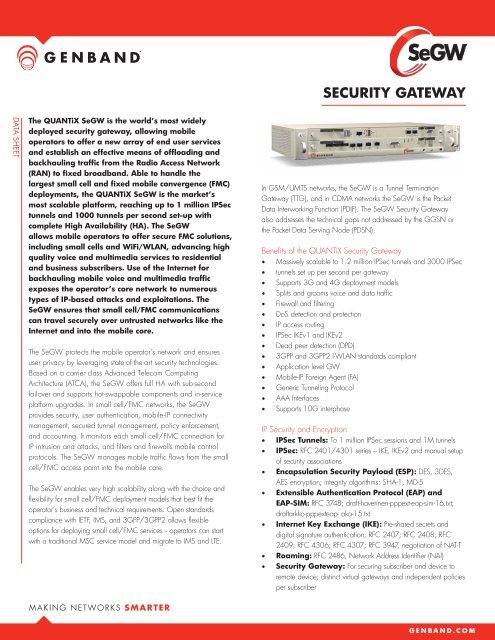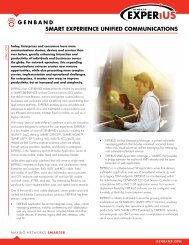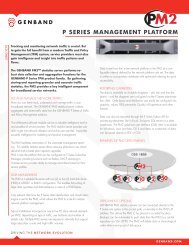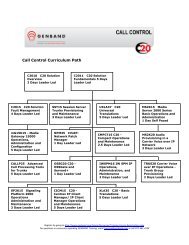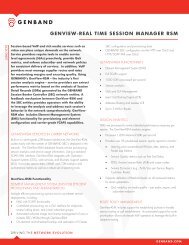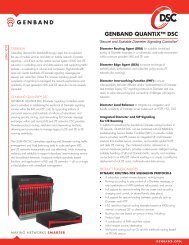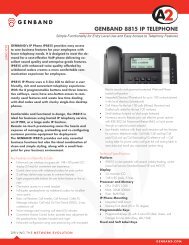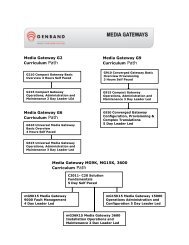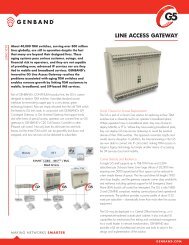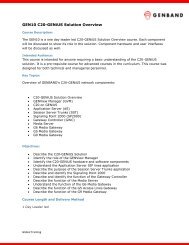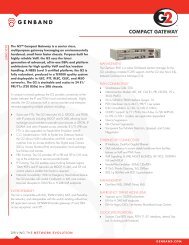Security Gateway Datasheet - Genband
Security Gateway Datasheet - Genband
Security Gateway Datasheet - Genband
You also want an ePaper? Increase the reach of your titles
YUMPU automatically turns print PDFs into web optimized ePapers that Google loves.
SECURITY GATEWAY<br />
The QUANTiX SeGW is the world’s most widely<br />
deployed security gateway, allowing mobile<br />
operators to offer a new array of end user services<br />
and establish an effective means of offloading and<br />
backhauling traffic from the Radio Access Network<br />
(RAN) to fixed broadband. Able to handle the<br />
largest small cell and fixed mobile convergence (FMC)<br />
deployments, the QUANTiX SeGW is the market’s<br />
most scalable platform, reaching up to 1 million IPSec<br />
tunnels and 1000 tunnels per second set-up with<br />
complete High Availability (HA). The SeGW<br />
allows mobile operators to offer secure FMC solutions,<br />
including small cells and WiFi/WLAN, advancing high<br />
quality voice and multimedia services to residential<br />
and business subscribers. Use of the Internet for<br />
backhauling mobile voice and multimedia traffic<br />
exposes the operator’s core network to numerous<br />
types of IP-based attacks and exploitations. The<br />
SeGW ensures that small cell/FMC communications<br />
can travel securely over untrusted networks like the<br />
Internet and into the mobile core.<br />
The SeGW protects the mobile operator’s network and ensures<br />
user privacy by leveraging state-of-the-art security technologies.<br />
Based on a carrier class Advanced Telecom Computing<br />
Architecture (ATCA), the SeGW offers full HA with sub-second<br />
failover and supports hot-swappable components and in-service<br />
platform upgrades. In small cell/FMC networks, the SeGW<br />
provides security, user authentication, mobile-IP connectivity<br />
management, secured tunnel management, policy enforcement,<br />
and accounting. It monitors each small cell/FMC connection for<br />
IP intrusion and attacks, and filters and firewalls mobile control<br />
protocols. The SeGW manages mobile traffic flows from the small<br />
cell/FMC access point into the mobile core.<br />
The SeGW enables very high scalability along with the choice and<br />
flexibility for small cell/FMC deployment models that best fit the<br />
operator’s business and technical requirements. Open standards<br />
compliance with IETF, IMS, and 3GPP/3GPP2 allows flexible<br />
options for deploying small cell/FMC services -- operators can start<br />
with a traditional MSC service model and migrate to IMS and LTE.<br />
In GSM/UMTS networks, the SeGW is a Tunnel Termination<br />
<strong>Gateway</strong> (TTG), and in CDMA networks the SeGW is the Packet<br />
Data Interworking Function (PDIF). The SeGW <strong>Security</strong> <strong>Gateway</strong><br />
also addresses the technical gaps not addressed by the GGSN or<br />
the Packet Data Serving Node (PDSN).<br />
Benefits of the QUANTiX <strong>Security</strong> <strong>Gateway</strong><br />
• Massively scalable to 1.2 million IPSec tunnels and 3000 IPSec<br />
• tunnels set up per second per gateway<br />
• Supports 3G and 4G deployment models<br />
• Splits and grooms voice and data traffic<br />
• Firewall and filtering<br />
• DoS detection and protection<br />
• IP access routing<br />
• IPSec IKEv1 and IKEv2<br />
• Dead peer detection (DPD)<br />
• 3GPP and 3GPP2 I-WLAN standards compliant<br />
• Application level GW<br />
• Mobile-IP Foreign Agent (FA)<br />
• Generic Tunneling Protocol<br />
• AAA Interfaces<br />
• Supports 10G interphase<br />
IP <strong>Security</strong> and Encryption<br />
• IPSec Tunnels: To 1 million IPSec sessions and 1M tunnels<br />
• IPSec: RFC 2401/4301 series – IKE, IKEv2 and manual setup<br />
of security associations<br />
• Encapsulation <strong>Security</strong> Payload (ESP): DES, 3DES,<br />
AES encryption; integrity algorithms: SHA-1, MD-5<br />
• Extensible Authentication Protocol (EAP) and<br />
EAP-SIM: RFC 3748; draft-haverinen-pppext-eap-sim-16.txt;<br />
draftarkko-pppexteap- aka-15.txt<br />
• Internet Key Exchange (IKE): Pre-shared secrets and<br />
digital signature authentication; RFC 2407; RFC 2408; RFC<br />
2409; RFC 4306; RFC 4307; RFC 3947, negotiation of NAT-T<br />
• Roaming: RFC 2486, Network Address Identifier (NAI)<br />
• <strong>Security</strong> <strong>Gateway</strong>: For securing subscriber and device to<br />
remote device; distinct virtual gateways and independent policies<br />
per subscriber
SECURITY GATEWAY<br />
• IPSec Clients: iQSecure and compatible with SafeNet, SSH<br />
supports XAUTH, MODE-CFG and NAT traversal<br />
• Digital Certificates: X.509v3<br />
• Encryption/Decryption Performance: Full line rate per<br />
interface simultaneously on all ports<br />
Firewall <strong>Security</strong><br />
• Firewall Filtering: Tailored subscriber firewall services at up<br />
to line rate per flow; filtering based on IP and transport headers<br />
with wildcards and masking, and on application type with<br />
stateful packet inspection; permit and deny filters<br />
• Stateful Packet Inspection: TCP, UDP, ICMP, and IP<br />
• Application Layer <strong>Gateway</strong>s: For FTP, SIP, ICMP and<br />
other port-agile applications<br />
• Concurrent Rules and Flows: Over 1 million stateful flows<br />
• Per-Flow Mirroring: Stateful mirroring of traffic flows for use<br />
with IDS systems on a per-subscriber, per-firewall rule basis<br />
• Statistical Thresholding: DOS/DDOS attack detection<br />
• DOS and DDOS Attack Prevention: Protection against<br />
common attacks, including SYN flood, LAND attack, SMURF,<br />
Ping of Death, and fragmentation attacks<br />
• Subscriber Session Limits: Adjustable session limits prevent<br />
resource exhaust and DOS/DDOS attacks<br />
• Anti-Spoofing: Protects against subscriber address spoofing<br />
• Real-Time Logging and Statistics: Logging of rule hits<br />
and violations in real-time; detailed session statistics. Firewall logs<br />
are WebTrends compliant<br />
• Subscriber Identification Rules: Recognized by source/<br />
destination IP prefix, IP address, next/ previous hop, incoming/<br />
outgoing tunnel, Virtual Router, and logical interface; a subscriber<br />
may be a site, host, network, or user<br />
• DiffServ: Full implementation; RFC 2474, RFC 2475, RFC<br />
2597, RFC 3246 and RFC 3247<br />
• Per Hop Behaviors (PHBs): Defined by Weighted<br />
Random Early Detection (WRED) queue admission control, drop<br />
precedence, queue priority, queue weight, delay bound, service<br />
type (UBR and CBR), and Layer 2 priority<br />
• Service Classes: Customizable based on Profile Action Sets<br />
(of 3 PHBs) allowing for special handling of out-of-profile traffic;<br />
several predefined standards-compliant service classes<br />
• Traffic Policing: Dual token-bucket policing; two-rate<br />
three color marker (RFC 2698); color aware and color-blind<br />
modes; applied to each service class instance; metered against<br />
provisioned traffic parameters<br />
• Class-based Link Sharing: Prioritized Weighed Fair<br />
Queuing (PWFQ) with WRED; WRED/queue parameters set<br />
by service class definitions<br />
• Traffic Shaping: Transport-independent traffic shaping on<br />
output; enables CBR services<br />
• IP Explicit Congestion Notification: RFC 2481; may<br />
be enabled or disabled<br />
• Statistical Thresholding: SLA monitoring<br />
Routing and Address Management<br />
• Dynamic and Static NAT: One-to-one IP address mapping;<br />
enabled per subscriber; RFC 1631, RFC 2663; detailed session<br />
statistics; NAPT: Multiple subscribers / hosts mapped to a single<br />
shared IP address; detailed session statistics<br />
• Mode-CFG: Per Virtual Router Address pools for IPsec Remote<br />
Clients<br />
• Dynamic Address Assignment: IPCP negotiation; DHCP<br />
relay with option 82; RADIUS attributes up to 4,096 802.1Q<br />
VLANs<br />
Services and System Management<br />
• High Availability Stateful Failover of IP Sessions:<br />
Sub-second fail-over with IP session state maintained during<br />
failover<br />
• GenView Management: Industry-standard CLI; Complete<br />
configuration and monitoring; multiple access privilege levels;<br />
access via Telnet, Telnet with IPsec, and SSH; management<br />
firewalls and ACLs; RADIUS authentication; full audit trail<br />
• Events and Alarms: SNMP Monitoring: SNMP v1/v2;<br />
relevant MIBs -- System, Environmental, IPSec, and Firewall;<br />
Multiple Syslog servers, SNMP traps, and Telco alarm panel<br />
connections<br />
• Accounting Data: Comprehensive real-time traffic statistics<br />
collected by subscriber and service (VPN, firewall, QoS, etc.);<br />
interface and backbone statistics via standard MIBs historical<br />
service auditing, RADIUS accounting; Supports up to 32,000<br />
subscribers<br />
1-866-GENBAND<br />
© 2013 GENBAND Inc. All rights reserved.<br />
The GENBAND logo is a registered trademark of GENBAND Inc.<br />
This document and any products or functionality it describes<br />
are subject to change without notice. Please contact GENBAND<br />
for additional information and updates.


